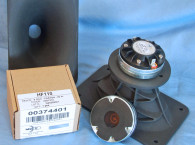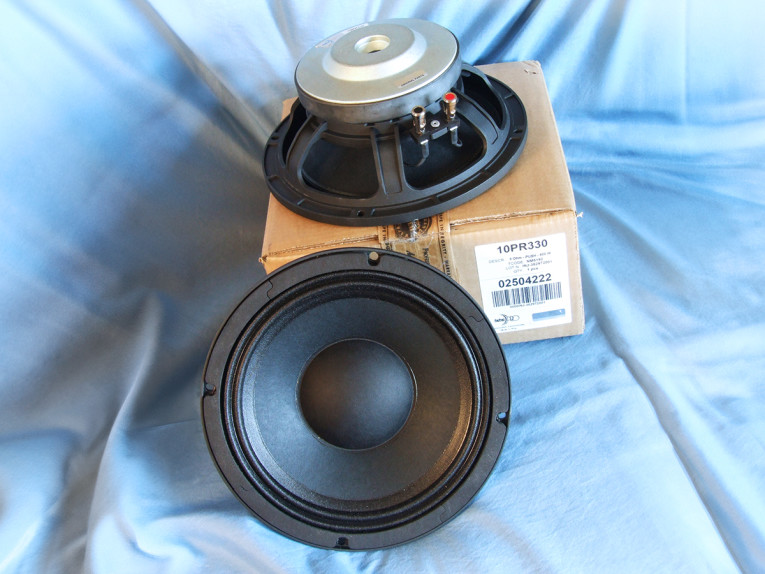
The feature set for the 10PR330 is like most high-performance pro sound drivers, fairly substantial. Starting with the frame, the 10PR330 uses a proprietary six-spoke cast-aluminum frame incorporating 12 7mm x 2mm rectangular flared vent holes in the area below the spider mounting shelf for enhanced voice coil cooling (Photo 2). This series of cooling vents allows air to move past the voice coil and across the milled polished and shaped front plate. Additional cooling is provided in a tapered and flared (on both ends) 20mm diameter pole vent.

I commenced testing using the LinearX LMS analyzer and Physical LAB IMP Box to create both voltage and admittance (current) curves with the driver clamped to a rigid test fixture in free air at 0.3V, 1V, 3V, 6V, 10V, 15V, 20V, and 30V, allowing the voice coil to progressively heat up between sweeps with a 200Hz sine wave. The Faital Pro driver remained sufficiently linear enough for LEAP 5 to curve fit at the 30V level.
Following my established protocol, I use the measured Mmd data (29.2 grams for the 10PR330). The 16 550-point stepped sine wave sweeps for each 10PR330 sample were post-processed and the voltage curves divided by the current curves to generate impedance curves, with the phase derived using the LMS calculation method, and along with the accompanying voltage curves, imported to the LEAP 5 Enclosure Shop software.
Because Thiele-Small (T-S) parameters provided by the majority of OEM manufacturers is generated using either the standard model or the LEAP 4 TSL model, I additionally created a LEAP 4 TSL parameter set using the 1V free-air curves. The complete data set, the multiple voltage impedance curves for the LTD model, and the single 1V impedance curve for the TSL model were selected in the Transducer Model Derivation menu in LEAP 5. Then, the parameters were created for the computer box simulations. Figure 1 shows the 1V free-air impedance curve. Table 1 compares the LEAP 5 LTD and TSL data and factory parameters for both Faital Pro 10PR330 samples.
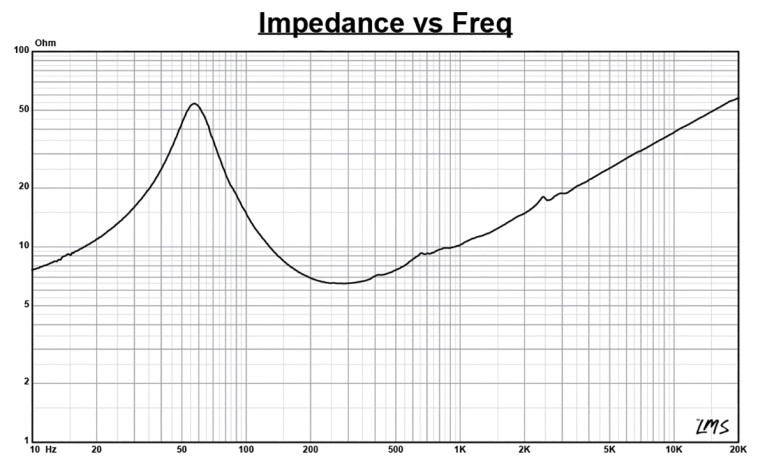
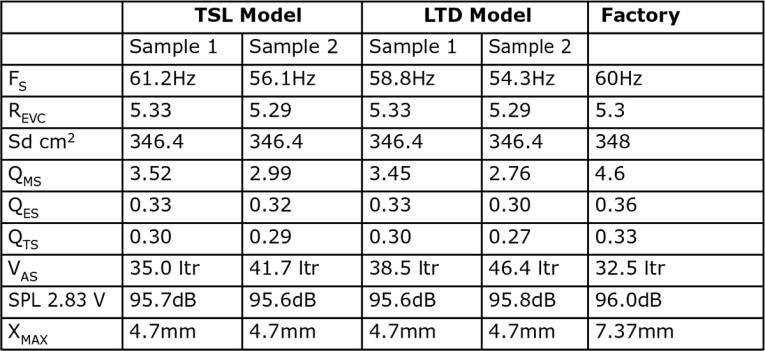
Xmax = [(winding depth - magnetic gap depth)/2] + (magnetic gap depth/3). It’s roughly equal to the excursion at the 10% distortion level that I publish from the Klippel analyzer.
Next, I configured computer enclosure simulations using the LEAP LTD parameters for Sample 1. I programmed two vented computer box simulations into LEAP 5 — the first being a QB3 alignment vented enclosure volume and tuning, which was 0.4ft3 with a 76Hz port tuning. The second simulation I created was a slightly modified Extended Bass Shelf (EBS) with a larger 0.8ft3 enclosure also tuned to 76Hz (since larger venues don’t have much in the way of room gain, I raised the tuning frequency for a flatter response).
Both simulations included 15% fiberglass fill material. Figure 2 displays the results for the 10PR330 in the two vented enclosures at 2.83V and at a voltage level sufficiently high enough to increase cone excursion to Xmax+15% (5.4mm for the 10PR330). This produced an F3 frequency of 108Hz (F6=85Hz) for QB3 and -3dB=69Hz (F6=63Hz) for the larger EBS vented simulation. Increasing the voltage input to the simulations until the maximum linear cone excursion was reached resulted in 124.5dB at 42V for the QB3 and 123dB for at 39.5V input level for the larger EBS vented box. Figure 3 shows the 2.83V group delay curves and Figure 4 shows the 42V/39.5V excursion curves.
The drivers start over excursing below at about 60Hz in both simulations, so an appropriate high-pass filter will increase the undistorted output considerably, but all vented enclosures should have a high-pass filter located somewhere below the tuning frequency.


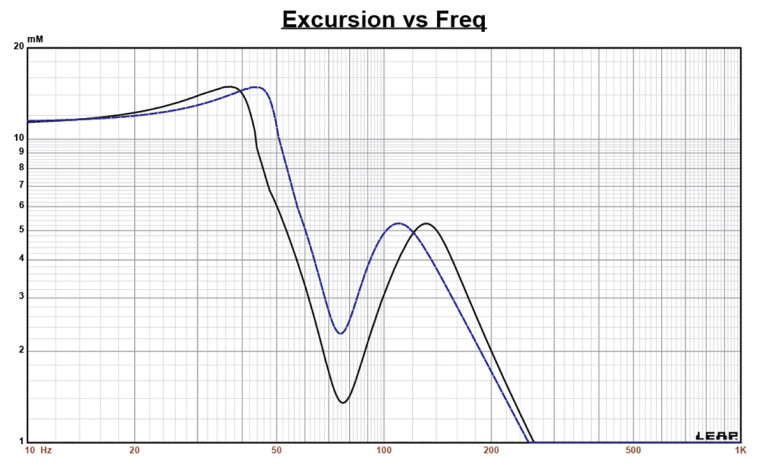
Klippel analysis for the Faital Pro 10” pro sound woofer, performed at Warkwyn by Jason Cochrane using the Klippel KA3 modular analyzer, produced the Bl(X), Kms(X), and Bl and Kms symmetry range plots given in Figures 5-8.
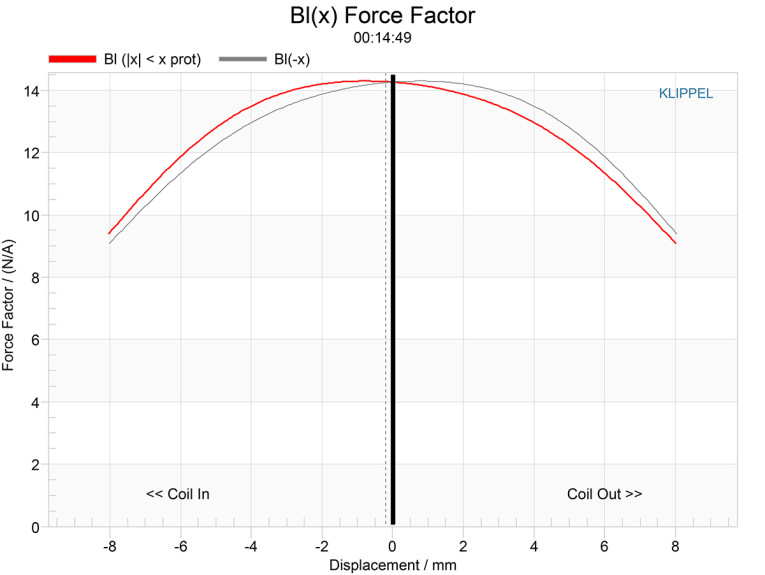
The Bl(X) curve for the Faital Pro 10PR330 (Figure 5) is moderately broad and symmetrical, typical of a medium Xmax driver, but with small amount of rearward (coil-in) offset. Looking at the Bl symmetry plot (Figure 6), at a point of reasonable certainty, this curve shows a small 0.55mm coil-in offset at the 3mm position, which decreases to 0.38mm at physical 4.7mm Xmax position, so not terribly significant.
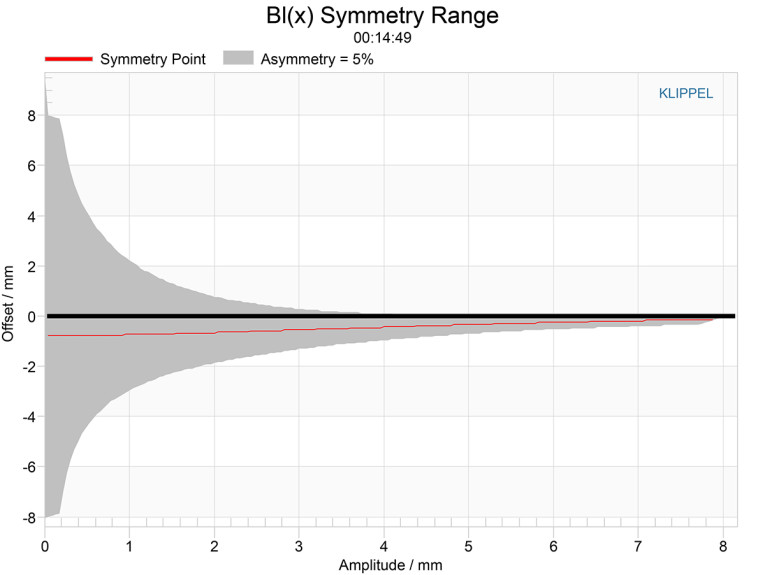
Figure 7 and Figure 8 show the Kms(X) and Kms symmetry range curves. The Kms(X) curve (Figure 7) is also moderately symmetrical in both directions accompanied by a small coil-out offset. Looking at the Kms symmetry range plot (Figure 8), the coil-out offset at the 4.7mm physical Xmax of the driver is only 0.18mm. Displacement limiting numbers calculated by the Klippel analyzer for the 10PR330 were XBl @ 82% Bl=5.67mm and for XC @ 75% Cms was 4.99mm, which means the compliance is the most limiting factor for prescribed distortion level of 10%, so more than suitable for a two-way application.
Both numbers were greater than the physical Xmax of the driver, so good performance. Figure 9 gives the inductance curves Le(X) for the 10PR330. Inductance will typically increase in the rear direction from the zero-rest position as the voice coil covers more pole area, which is what is happening here. The inductance swing for this driver varies from 0.63mH to 1.06mH from Xmax in to Xmax out, which is not so bad for a motor that does not have an aluminum or copper shorting ring installed.
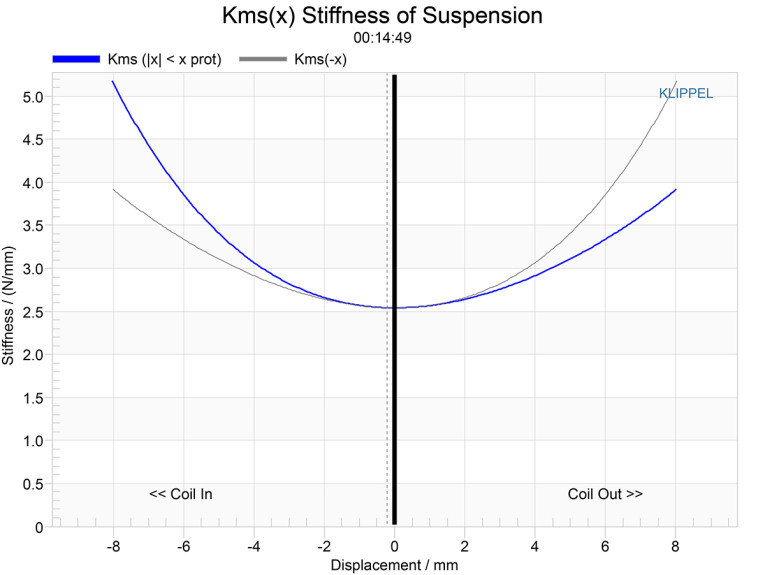


Next, I mounted the 10PR330 woofer in a foam-filled enclosure that had a 23”x15” baffle and measured the device under test (DUT) using the Loudsoft FINE R+D analyzer and the GRAS 46BE microphone (courtesy of Loudsoft and GRAS Sound & Vibration) both on- and off-axis from 200Hz to 20kHz at 2V/0.5m, normalized to 2.83V/1m using the cosine windowed Fast Fourier Transform (FFT) method.
Figure 10 gives the on-axis response, indicating a smoothly rising response 300Hz to 800Hz followed by a 4dB drop in the response out to a breakup mode centered on 3kHz just before the low-pass roll-off. Figure 11 displays the on- and off-axis frequency response at 0°, 15°, 30°, and 45°, showing the typical directivity for a 10” woofer. The -3dB at 30° with respect to the on-axis curve occurs at about 1.75kHz, so a reasonable frequency (or lower) for a low-pass crossover filter. Figure 12 shows the normalized version of Figure 11. Figure 13 shows the CLIO polar plot (in 10° increments and 1/3 octave smoothing). And finally, Figure 14 displays the two-sample SPL comparisons for the 10” Faital Pro driver, showing a close match ≤0.7dB throughout the operating range up to 2kHz.


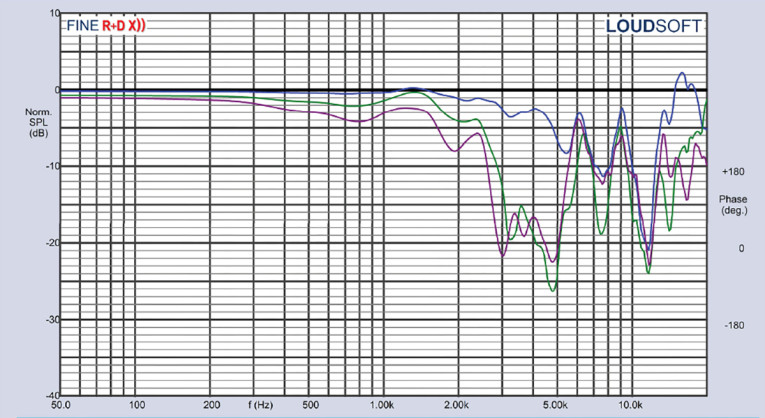
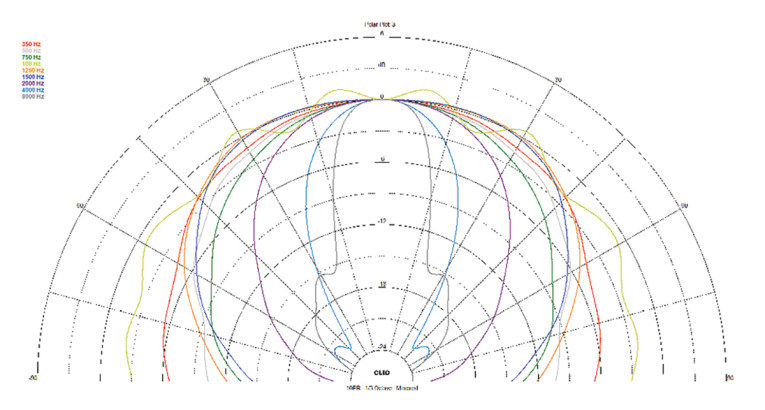

For the last remaining series of tests on the 10PR330, I again employed the Listen SoundCheck AudioConnect analyzer and SCM ¼” microphone to measure distortion and generate time-frequency plots. For the distortion measurement, the 10” driver was mounted rigidly in free air, and the SPL set to 104dB at 1m (10.96V) using a pink noise stimulus. Then, the distortion was measured with the Listen microphone placed 10cm from the driver. This produced the distortion curves shown in Figure 15.
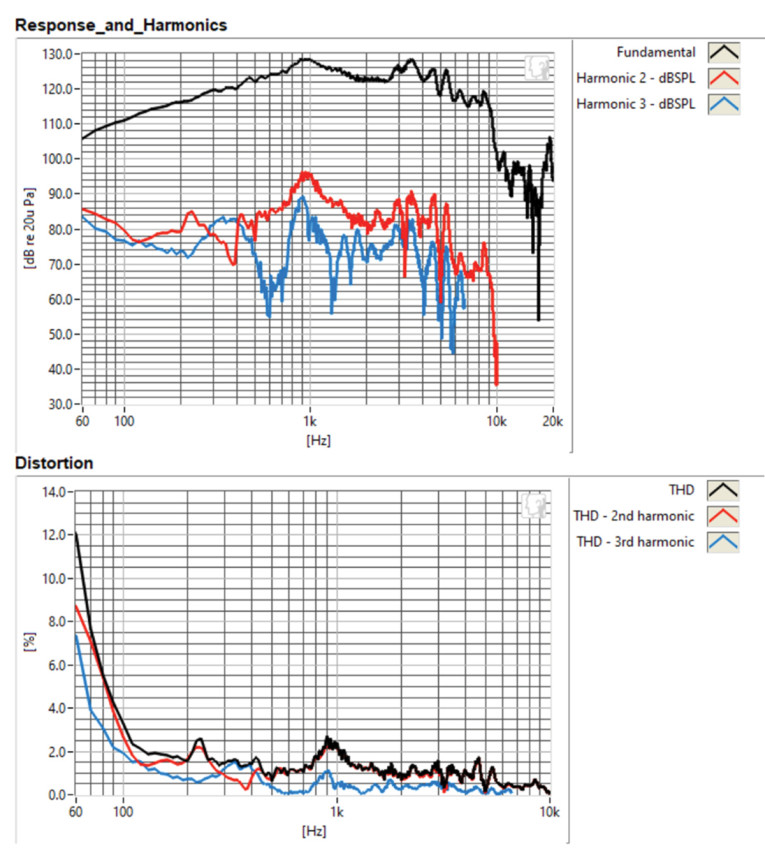
I then used SoundCheck to get a 2.83V/1m impulse response for this driver and imported the data into Listen’s SoundMap Time/Frequency software. Figure 16 shows the resulting cumulative spectral decay (CSD) waterfall plot. Figure 17 shows the Wigner-Ville plot (chosen for its better low-frequency performance).
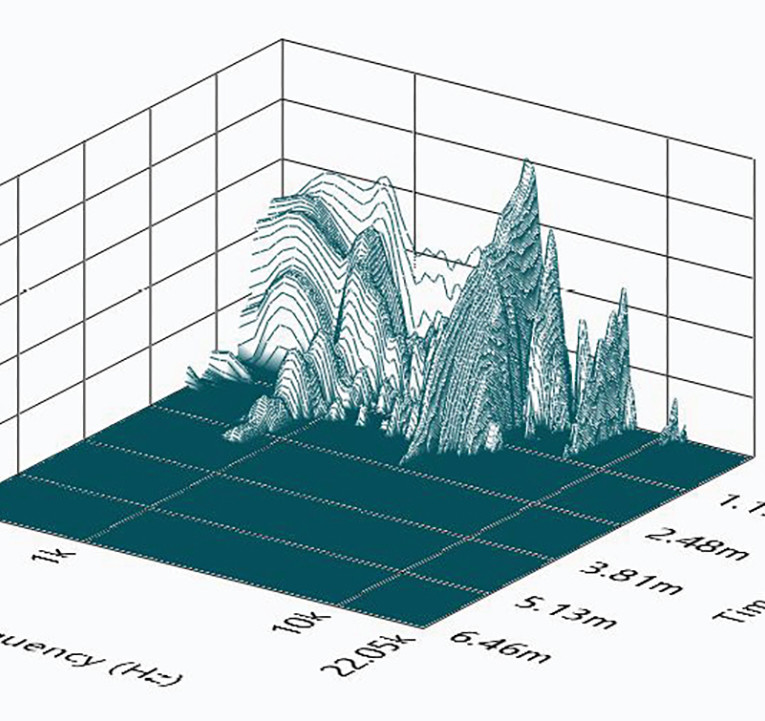
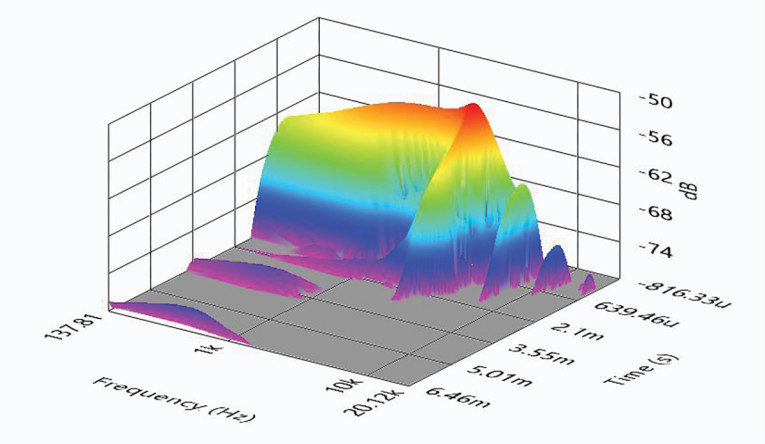
Given the data collected, and the consistently good performance and build quality exhibited by Faital Pro woofers, the 10PR330 looks like an excellent to addition to Faital’s extensive 10” woofer category, which includes 15 models with the inclusion of the 10PR330. For more information, visit www.faitalpro.com. VC
This article was originally published in Voice Coil, June 2024




